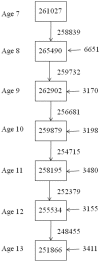Growth in height in childhood and risk of coronary heart disease in adult men and women
- PMID: 22291964
- PMCID: PMC3265486
- DOI: 10.1371/journal.pone.0030476
Growth in height in childhood and risk of coronary heart disease in adult men and women
Abstract
Background: Adult height is inversely associated with the risk of coronary heart disease (CHD), but it is still unknown which phase of the human growth period is critical for the formation of this association. We investigated the association between growth in height from 7 to 13 years of age and the risk of CHD in adulthood.
Methods and findings: The heights of almost all children born 1930 through 1976 who attended school in the Copenhagen municipality (232,063 children) were measured annually from 7 to 13 years of age. Birth weight data were available since 1936. Fatal and non-fatal CHD events were ascertained by register linkage until 2008 (25,214 cases). Hazard ratios (HR) with 95% confidence intervals (CI) were estimated by Cox proportional hazards regression for height z-scores (standard deviation units) and change in height z-scores. Height z-scores were inversely related to the risk of CHD. The association was strongest at 7 years of age (HR = 0.91, CI 0.90-0.92 in boys and 0.88, CI 0.86-0.90 in girls) and steadily weakened thereafter, yet it still remained at 13 years of age (HR = 0.95, CI 0.94-0.97 and 0.91, CI 0.89-0.93, boys and girls respectively). The associations were not modified by birth weight. Independent of the age-specific risk, rapid growth was associated with an increased CHD risk, most pronounced between 9 and 11 years in girls (HR = 1.22, CI 1.14-1.31) and between 11 and 13 years in boys (HR = 1.28, CI 1.22-1.33) per unit increase in z-score. Adjustment for body mass index somewhat strengthened the associations of CHD risk with height and weakened the association with growth.
Conclusions/significance: Risk of CHD in adulthood is inversely related to height at ages 7 through 13 years, but strongest in the youngest, and, independently hereof, the risk increased by growth velocity.
Conflict of interest statement
Figures



References
-
- Singhal A, Lucas A. Early origins of cardiovascular disease: is there a unifying hypothesis? Lancet. 2004;363:1642–1645. - PubMed
-
- Gamborg M, Byberg L, Rasmussen F, Andersen PK, Baker JL, et al. Birth weight and systolic blood pressure in adolescence and adulthood: meta-regression analysis of sex- and age-specific results from 20 Nordic studies. Am J Epidemiol. 2007;166:634–645. - PubMed
-
- Risnes KR, Vatten LJ, Baker JL, Jameson K, Sovio U, et al. Birthweight and mortality in adulthood: a systematic review and meta-analysis. Int J Epidemiol. 2011;40:647–661. - PubMed
-
- Paajanen TA, Oksala NK, Kuukasjärvi P, Karhunen PJ. Short stature is associated with coronary heart disease: a systematic review of the literature and a meta-analysis. Eur Heart J. 2010;31:1802–1809. - PubMed
-
- Sørensen HT, Sabroe S, Rothman KJ, Gillman M, Steffensen FH, et al. Birth weight and length as predictors for adult height. Am J Epidemiol. 1999;149:726–729. - PubMed

